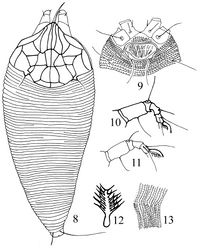Gammaphytoptus schimae
| Notice: | This page is derived from the original publication listed below, whose author(s) should always be credited. Further contributors may edit and improve the content of this page and, consequently, need to be credited as well (see page history). Any assessment of factual correctness requires a careful review of the original article as well as of subsequent contributions.
If you are uncertain whether your planned contribution is correct or not, we suggest that you use the associated discussion page instead of editing the page directly. This page should be cited as follows (rationale):
Citation formats to copy and paste
BibTeX: @article{Wang2012ZooKeys180, RIS/ Endnote: TY - JOUR Wikipedia/ Citizendium: <ref name="Wang2012ZooKeys180">{{Citation See also the citation download page at the journal. |
Ordo: Trombidiformes
Familia: Eriophyidae
Genus: Gammaphytoptus
Name
Gammaphytoptus schimae Wang & Wei & Yang, 2012 sp. n. – Wikispecies link – Pensoft Profile
Diagnosis
Body fusiform, yellow. Gnathosoma curved obliquely downward, dorsal genual setae (d) bend forming obtuse angle at middle. Prodorsal shield with frontal lobe present; all lines bold and connected with transverse lines forming network; scapular tubercles and setae absent. Coxisternal plates sculptured with lines, prosternal apodeme present, coxigenital annuli 4. Legs segments normal, legs II with genual setae (l’’) absent, tarsal empodium entire, 6-rayed, tarsal solenidion knobbed. Dorsal opisthosoma with shallow median furrow, dorsal annuli smooth; ventral annuli with rounded microtubercles, setae h1 absent. Female genitalia coverflap with two rows of ridges.
Description
Female (n = 11). Body fusiform, yellow, 183 (169–200), 71 (65–78) wide, 44 (38–52) thick.
Gnathosoma. Curved obliquely downward, 34 (28–35), coxal setae (ep) 2 (2–3), dorsal genual setae (d) 10 (9–11); cheliceral stylets 30 (28–32).
Prodorsal shield. 51 (48–52), 55 (50–63) wide, frontal lobe present; median, admedian and submedian lines complete, connected with three transverse lines forming network; scapular tubercles placed at rear shield margin, 35 (31–39) apart, scapular setae (sc) 8 (8–9), directed backward and divergence.
Coxisternal plates. Prosternal apodeme present, coxisternal plates smooth; anterolateral setae on coxisternum I (1b) 8 (7–9), 13 (12–13) apart; proximal setae on coxisternum I (1a) 25 (19–31), 15 (14–15) apart; proximal setae on coxisternum II (2a) 35 (28–39), 28 (27–30) apart. Coxigenital annuli 4.
Legs. Segments normal. Legs I 36 (34–38), trochanter 2 (2), femur 12 (12–13), femoral setae (bv) 18 (15–22); genu 4 (4–5), genual setae (l’’) 35 (31–40); tibia 10 (9–10), tibial setae (l') located 1/4 from apical, 8 (7–8); tarsus 8 (7–8), iner fastigial tarsal setae (ft’) 20 (18–23), outer fastigial tarsal setae (ft’’) 25 (23–28), unguinal tarsal setae (u’) 5 (5–6); tarsal empodium entire, 7 (7–8), 6-rayed, tarsal solenidion 10 (9–10), knobbed. Legs II 31 (29–34), trochanter 2 (2), femur 11 (11–12), femoral setae (bv) 23 (19–27); genu 3 (3–4), genual setae (l’’) 10 (7–12); tibia 7 (7–8); tarsus 8 (7–8), inner fastigial tarsal setae (ft’) 10 (9–12), outer fastigial tarsal setae (ft’’) 25 (22–29), unguinal tarsal setae (u’) 5 (5–6); tarsal empodium entire, 8 (8–9), 6-rayed, tarsal solenidion 10 (9–11), knobbed.
Opisthosoma. Dorsum evenly rounded, dorsal annuli 59–60, with semi-translucency elongated microtubercles; ventral annuli 81, with filament microtubercles; setae c2 38 (35–40), on ventral annulus 13th; setae d 45 (37–50), 43 (38–45) apart, on ventral annulus 28th; setae e 27 (23–32), 25 (23–26) apart, on ventral annulus 44th; setae f 38 (34–45), 23 (21–26) apart, on 7th ventral annulus from rear; setae h1 absent, setae h2 57 (53–65).
Female genitalia. Near coxisternal plates, coverflap with two rows of ridges, 17 (16–18), 30 (29–22) wide, proximal setae on coxisternum III (3a) 20 (17–25), 13 (13–14) apart.
Male. Unknown.
Type material
Holotype female, China: Zhejiang, Longquan City, Fengyangshan National Nature Reserve (27°53'N, 119°11'E), 28. VII. 2007, collected by Guo-Quan Wang, from Schima superba Gardn.&Champ. (Theaceae). Paratypes, 8 females.
Distribution
China (Zhejiang).
Etymology
The species is named from the generic name of the type host plant.
Remarks
This new species is similar to Gammaphytoptus zuihoensus Huang & Wang, 2004, but they can be easily separated as follows: in Gammaphytoptus schimae, median line is complete, setae h1 is absent and infesting Schima superba Gardn.&Champ.; in Gammaphytoptus zuihoensus, median line is incomplete, setae h1 is present and infesting Machilus zuihoensis Hay. var. zuihoensis (Huang and Wang 2004[1]).
Original Description
- Wang, G; Wei, S; Yang, D; 2012: A new genus, two new species and a new record of subfamily Cecidophyinae (Acari, Eriophyidae) from China ZooKeys, 180: 9-18. doi
Other References
- ↑ Huang K, Wang C (2004) Eriophyoid mites of Taiwan: Description of nine species of Cecidophyinae and Eriophyinae from Hueysuen (Acari: Eriophyoidea). Plant Protection Bulletin 46: 55-68.
Images
|
